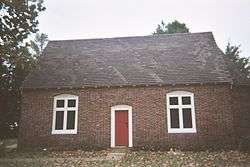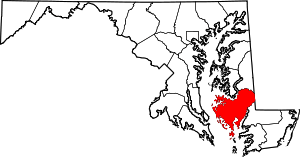Church Creek, Maryland
| Church Creek, Maryland | |
|---|---|
| Town | |
 Location of Church Creek, Maryland | |
| Coordinates: 38°30′19″N 76°9′16″W / 38.50528°N 76.15444°WCoordinates: 38°30′19″N 76°9′16″W / 38.50528°N 76.15444°W | |
| Country | United States |
| State | Maryland |
| County | Dorchester |
| Incorporated | 1867 |
| Government | |
| • Type | Town commission |
| • Mayor | Robert L. Herbert |
| Area[1] | |
| • Total | 0.34 sq mi (0.88 km2) |
| • Land | 0.34 sq mi (0.88 km2) |
| • Water | 0 sq mi (0 km2) |
| Elevation | 3 ft (1 m) |
| Population (2010)[2] | |
| • Total | 125 |
| • Estimate (2012[3]) | 124 |
| • Density | 367.6/sq mi (141.9/km2) |
| Time zone | Eastern (EST) (UTC-5) |
| • Summer (DST) | EDT (UTC-4) |
| ZIP code | 21622 |
| Area code(s) | 410 |
| FIPS code | 24-17050 |
| GNIS feature ID | 0589976 |
| Website |
msa |
Church Creek is a town in Dorchester County, Maryland, United States. The population was 125 at the 2010 census. Church Creek is about 6 mi south of Cambridge. Old Trinity Church, the oldest church building in the US in continuous use, an Episcopal/Anglican brick church built in 1675, is located here.
Geography
Church Creek is located at 38°30′19″N 76°9′16″W / 38.50528°N 76.15444°W (38.505300, -76.154367).[4] The town is located at the head of the Church Creek river, a tributary of Little Choptank River.
According to the United States Census Bureau, the town has a total area of 0.34 square miles (0.88 km2), all of it land.[1]
Climate
The climate in this area is characterized by hot, humid summers and generally mild to cool winters. According to the Köppen Climate Classification system, Church Creek has a humid subtropical climate, abbreviated "Cfa" on climate maps.[5]
Demographics
| Historical population | |||
|---|---|---|---|
| Census | Pop. | %± | |
| 1880 | 331 | — | |
| 1890 | 396 | 19.6% | |
| 1950 | 187 | — | |
| 1960 | 146 | −21.9% | |
| 1970 | 130 | −11.0% | |
| 1980 | 124 | −4.6% | |
| 1990 | 113 | −8.9% | |
| 2000 | 85 | −24.8% | |
| 2010 | 125 | 47.1% | |
| Est. 2014 | 124 | [6] | −0.8% |
2010 census
As of the census[2] of 2010, there were 125 people, 59 households, and 37 families residing in the town. The population density was 367.6 inhabitants per square mile (141.9/km2). There were 67 housing units at an average density of 197.1 per square mile (76.1/km2). The racial makeup of the town was 89.6% White, 6.4% African American, 0.8% from other races, and 3.2% from two or more races. Hispanic or Latino of any race were 4.8% of the population.
There were 59 households of which 23.7% had children under the age of 18 living with them, 47.5% were married couples living together, 11.9% had a female householder with no husband present, 3.4% had a male householder with no wife present, and 37.3% were non-families. 32.2% of all households were made up of individuals and 15.3% had someone living alone who was 65 years of age or older. The average household size was 2.12 and the average family size was 2.65.
The median age in the town was 47.8 years. 16% of residents were under the age of 18; 9.6% were between the ages of 18 and 24; 20% were from 25 to 44; 32% were from 45 to 64; and 22.4% were 65 years of age or older. The gender makeup of the town was 44.8% male and 55.2% female.
2000 census
As of the census[8] of 2000, there were 85 people, 41 households, and 25 families residing in the town. The population density was 271.4 people per square mile (105.9/km²). There were 45 housing units at an average density of 143.7 per square mile (56.0/km²). The racial makeup of the town was 100.00% White.
There were 41 households out of which 24.4% had children under the age of 18 living with them, 48.8% were married couples living together, 9.8% had a female householder with no husband present, and 36.6% were non-families. 36.6% of all households were made up of individuals and 17.1% had someone living alone who was 65 years of age or older. The average household size was 2.07 and the average family size was 2.69.
In the town the population was spread out with 23.5% under the age of 18, 1.2% from 18 to 24, 29.4% from 25 to 44, 21.2% from 45 to 64, and 24.7% who were 65 years of age or older. The median age was 42 years. For every 100 females there were 93.2 males. For every 100 females age 18 and over, there were 85.7 males.
The median income for a household in the town was $25,750, and the median income for a family was $26,875. Males had a median income of $21,250 versus $16,250 for females. The per capita income for the town was $19,700. None of the population and none of the families were below the poverty line.
History

The exact origins of Church Creek remain unclear. Popular tradition maintains that Church Creek predates Cambridge, Maryland as the earliest settlement in Dorchester County, and was first established at some point before 1684 under the name Dorchester Town and then White Haven.[9] However the accuracy of this claim has been disputed by historian Elias Jones, who found no indication of land sales in the area before 1700 in County Land Records.[10] Both the town and river of Church Creek derive their name from the nearby Episcopal church, now known as Old Trinity Church, built c. 1675.[11][12] In 1867, Church Creek officially became the forty-second Incorporated town in Maryland, and remains one of the one-hundred and twenty-three such towns today. In 1975, the town adopted its first municipal tax in order to qualify for state tax grants and federal revenue-sharing.[13]
Economy
The first major industry in Church Creek was shipbuilding, established at some point before 1767, which took advantage of surrounding forests plentiful with white oak and pine.[10] As a result, the population of the town grew during the 18th and 19th centuries. The 1860 census recorded two-hundred and eighteen families and one-thousand one-hundred and three residents, of which 51 percent were occupied as “laborers” and 26 percent occupied as “farmers”.[14] Towards the end of the 19th century, a dearth of timber resources due to regional deforestation and a downturn in the wooden shipbuilding industry greatly impacted the industrial prosperity of Church Creek, and the population subsequently declined.[10] The economy of Church Creek has also historically benefited from human traffic resulting from the town’s location, which is situated at the crossroads of Taylor’s Island Road (Route 16) and Church Creek-Golden Hill Road (Route 335). During the first half of the twentieth century, the residents of Church Creek maintained eight or nine general stores.[10][15] Nonetheless, the continued decline of Church Creek’s economic prosperity during the second half of the twentieth century has been mirrored by its decreasing population. According to the United States Census Records, the town contained one-hundred and eighty-seven people in 1950 and just one-hundred and fifteen in 1990.[16]
African American Education During Reconstruction
The town of Church Creek also played a role in the advancement of state-sponsored African American education during the Reconstruction. Despite the Public Instruction Act of 1865, which earmarked public funds for the education of African American students, Maryland county and city school boards refused to distribute the allocated money for the building and maintenance of African American schools.[17] Instead, private organizations such as the American Missionary Association spearheaded the raising and allocation of money throughout Maryland.[17] The fifth African American County school was established in Church Creek on September 27, 1865 under the care of Mary S. Osbourne with a total enrollment of thirty-two students.[18] The County schools quickly encountered protest from local residents and, occasionally, violence. In October and November 1865, arsonists destroyed African American schools in Millington, Edesville and Kent County.[19] Though the school at Church Creek was not attacked, it did encounter local antagonism. In December 1865, a group of Church Creek residents held an “indignation meeting” to organize and communicate their opposition to the African American school and its teacher, Mary S. Osbourne.[19] However, the Church Creek school for African American students continued to operate successfully throughout the 1865-66 school year. As teacher Mary S. Osbourne reported: “One class of six knew the alphabet but could not read at all; now they read well, as far as First Step No. 12 on the Chart…A class of seven read well in the First Reader, and are to commence Arithmetic at once. Another… [is] using the Third Reader and studying Geography.”[20]
References
- 1 2 "US Gazetteer files 2010". United States Census Bureau. Retrieved 2013-01-25.
- 1 2 "American FactFinder". United States Census Bureau. Retrieved 2013-01-25.
- ↑ "Population Estimates". United States Census Bureau. Retrieved 2013-06-26.
- ↑ "US Gazetteer files: 2010, 2000, and 1990". United States Census Bureau. 2011-02-12. Retrieved 2011-04-23.
- ↑ Climate Summary for Church Creek, Maryland
- ↑ "Annual Estimates of the Resident Population for Incorporated Places: April 1, 2010 to July 1, 2014". Retrieved June 4, 2015.
- ↑ "Census of Population and Housing". Census.gov. Retrieved June 4, 2015.
- ↑ "American FactFinder". United States Census Bureau. Retrieved 2008-01-31.
- ↑ Dorchester County Resources Committee. "This is Dorchester County, Maryland". Cambridge, Maryland, 1952. p 46.
- 1 2 3 4 Jones, Elias. "New Revised History of Dorchester County, Maryland". Cambridge, Maryland: Tidewater Publishers, 1966. pp 106-7.
- ↑ "Old Trinity Church HABS MD No. 201" (PDF). Historic American Buildings Survey. US National Park Service. Retrieved 6 May 2014.
- ↑ Wroten, William H. Jr. "The Protestant Episcopal Church in Dorchester County, 1692-1860". Maryland Historical Magazine 45 (1950): p 106.
- ↑ Megargee, Frank. "Shore Town of Church Creek Adopts Its First Tax In History." Evening Sun, 2 July 1975.
- ↑ Molisani, Jackie. "1860 Census of Dorchester County, Maryland." USA: Family Line Publications, 1984.
- ↑ Wharton, Carol. "Sam H. Jones: Mackerel-Barrel Philosopher". Baltimore Sun, 4 August 1946.
- ↑ "Church Creek". <http://www.mdmunicipal.org/cities/index.cfm?townname=churchcreek&page=home> Cited 23 April 2008.
- 1 2 Fuke, Richard Paul. "The Baltimore Association For The Moral And Educational Improvement Of The Colored People, 1864-1870". Maryland Historical Magazine. 66 (1971): 371-373
- ↑ Fuke, Richard Paul. "The Baltimore Association For The Moral And Educational Improvement Of The Colored People, 1864-1870". Maryland Historical Magazine. 66 (1971): pp 377-378
- 1 2 Fuke, Richard Paul. "The Baltimore Association For The Moral And Educational Improvement Of The Colored People, 1864-1870". Maryland Historical Magazine. 66 (1971): pp 381-382
- ↑ Fuke, Richard Paul. "The Baltimore Association For The Moral And Educational Improvement Of The Colored People, 1864-1870". Maryland Historical Magazine. 66 (1971): pp 384
| |||||||||||||||||||||||||||||
